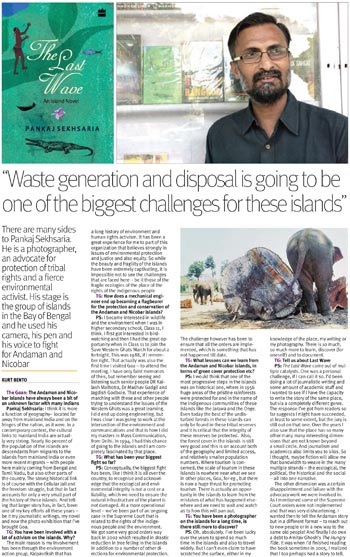
The Last Wave

"Waste generation and disposal is going to be one of the biggest challenges for these islands".
There are many sides to Pankaj Sekhsaria. He is a photographer, an advocate for protection of tribal rights and a fierce environmental activist. His stage is the group of islands in the Bay of Bengal and he used his camera, his pen and his voice to fight for Andaman and Nicobar.
Q: The Andaman and Nicobar islands have always been a bit of an unknown factor with many Indians
A: I think it is more a function of geography- located far away from mainland India and on the fringes of the nation, as it were. In a contemporary context, the cultural links to mainland India are actually very strong. Nearly 80 percent of the population of the islands are descendants from migrants to the islands from mainland India or even more recent migrants – with people here mainly coming from Bengal and Tamil Nadu, but also other parts of the country. The strong historical link is of course with the cellular Jail and the freedom struggle, but that in fact accounts for only a very small part of the history of these islands. And telling that larger story has, in fact, bee one of my key efforts all these years – be it my journalistic writings, my novel and now the photo exhibition that I’ve brought Goa.
Q: You have been involved with a lot of activism on the islands. Why?
A: The main reason is my involvement has been through the environment action group, Kalpavrish that has a long history of environment and human rights activism. It has been a great experience for me to part of this organization that believes strongly in issues of environmental protection and justice and also equity. So while the beauty and fragility of the islands have been extremely captivating, it is impossible not to see the challenges that are faced here – be it those of the fragile ecologies of the place of the rights of the indigenous people.
Q: How does a mechanical engineer end up becoming a flagbearer for the protection and conservation of the Andaman and Nicobar islands?
A: I became interested in wildlife and the environment when I was in higher secondary school, class 11, I think. I first got interested in birdwatching and then I had the great opportunity when in class 11 to join the Save Western Ghats March for about a fortnight. This was 1988, if I remember right. That actually was also the first time I visited Goa – to attend the meeting. I have only faint memories of then, but remember seeing and listening such senior people DR Kailash Malhotra, Dr Madhav Gadgil and Jagdish Godbole. That experience of marching with these and other people trying to understand the issues of the Western Ghats was a great learning. I did end up doing engineering, but I was clear I was going to work at the intersection of the environment and communications and that is how I did my masters in Mass Communication, from Delhi. In 1994, I had this chance of going to the islands and I am completely fascinated by that place.
Q: What has been your biggest fight so far?
A: Conceptually, the biggest fight has been, like I think it is all over the country, to recognise and acknowledge that the ecological and environmental integrity is not a cost or a liability, which we need to ensure that the natural infrastructure of the planet is not damaged. At a more operational level – we’ve been part of an ongoing case in the Supreme Court that is related to the right dog the indigenous people and the environment. We got some very good orders way back in 2002 which resulted in drastic reduction in tree felling in the islands in addition to a number of other directions for environmental protection. The challenge however has been to ensure that all the orders are implemented, which is something that has not happened till date.
Q: What lessons can we learn from the Andaman and Nicobar Islands, in terms of green cover protection etc?
A: I would think that one of the most progressive steps in the islands was an historical one, where in 1956 huge areas if the pristine rainforests were protected for and in the name of the indigenous communities of these islands like the Jarawa and the Onge. Even today the best of the undisturbed forests in these islands can only be found in these tribal reserves and it is critical that the integrity of these reserves be protected. Also, the forest cover in the islands is still very good and this is on account both of the geography and limited access, and relatively smaller population numbers. Where tourism is concerned, the scale of tourism in these islands is nowhere near what we see on other places, Goan for eg., but there is now a huge thrust for promoting tourism. There is actually an opportunity in the islands to learn from the mistakes of what has happened elsewhere and we need to wait and watch as to how this will pan out.
Q: You have been a photographer on the islands for a long time, is there still more to discover?
A: Oh, absolutely. I’ve been lucky over the years to spend so much time in the islands and also to travel widely. But I can’t even claim to have scratched the surface, either in my knowledge of the place, my writing or my photography. There is so much, so much more to learn, discover (for oneself) and to document.
Q: Tell us about Last Wave
A: The Last Wave came out of multiple catalysts. One was a personal challenge, if I can call it so. I’d been doing a lot of journalistic writing and some amount of academic stuff and I wanted to see if I have the capacity to writ the story of the same place, but via a completely different genre. The response I’ve got from the readers so far suggests I might have succeeded, at least too some extent, but the jury is still out on that one. Over the years I also saw that the place has so many other many many interesting dimensions that are not known beyond a small circle. And journalism and academics also limits you to silos. So I thought, may be fiction will allow me that bandwidth to weave in the many multiple strands – the ecological, the political, the historical and the social – all into one narrative.
The other dimension was a certain disappointment and failure with the advocacy work we were involved in. as I mentioned some of the Supreme Court orders were not implemented and that was very disheartening. I wanted then to tell the Andaman story but in a different format - to reach out to new people or in a new way to the same old people! And finally I do owe a debt to Amitav Ghosh’s The Hungry Tide. It was when I’d finished reading the book sometime in 2005, I realized that I too perhaps had a story to tell.





